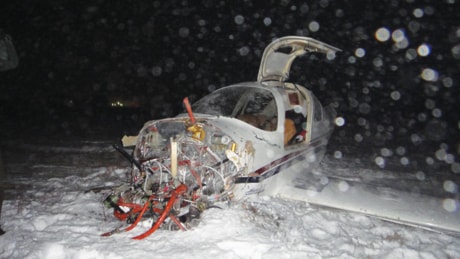A 54-year-old Red Deer optometrist who walked away from a plane crash on Nov. 28 had promised his wife that he would stop flying it when he reached 55.
A seasoned pilot, Gerry Leinweber was flying his single-engine Lancair IV-P from Edmonton to Wetaskiwin at about 9 p.m. to drop off a business associate — fellow optometrist Bruce Johnson, 42.
It was a clear night with a bright moon. Therefore, although some of his instruments were acting up, Leinweber felt confident flying by visual rules.
Leinweber said from his clinic in Red Deer on Thursday that he had already filed his flight plan for the trip back to Red Deer and was on his descent to Wetaskiwin when the plane hit fog.
He instantly switched to instrument flying, asking Johnson to watch out the windows and let him know when he could see the ground.
“We hit the fog and I say to Bruce, ‘You just watch for the ground. If you can see the runway, we’ll land. Otherwise, we’ll go to Red Deer and I’ll drive you back to Wetaskiwin.”
Leinweber said if he still couldn’t see at about 200 metres, he would abort the landing.
He had declared a missed approach and was starting to pull the nose up to head for Red Deer when the plane hit the ground, bounced over some trees and hit again in a field about 1.5 km south of the Wetaskiwin airport.
Because he thought he was still at 200 metres, Leinweber thought he had hit something in midair.
After the plane stopped, he opened the doors and the two men got out, uninjured. Looking back, Leinweber could see the broken remains of the airplane worth half a million dollars that had taken he and co-owner Gerry Mulder four years to build.
The wings, which were carrying a full load of fuel, were shorn off on the first impact. Fuel spilled out but did not catch fire. The carbon fibre envelope in which the men had been sitting remained intact. While Leinweber got a few cuts on his right fist and right shin, Johnson escaped the crash without a scratch.
The Lancair IV-P is a kit plane, noted for safety, reliability, high air speeds and a pressurized cabin. Leinweber normally flies it at about 7,600 metres (25,000 feet) and just under the speed of a jet.
“The only reason we are alive is because of how well built the plane is — better than any metal plane. The carbon fibre is the same material an F18 or stealth bomber is made of and it is amazing,” he said.
“If I was in a Cessna or a Piper, I’d be dead.”
Besides the extra strength built into the airplane, it is operated by a joystick rather than a steering column, which was an additional factor in preventing injuries, said Leinweber.
While the Transportation Safety Board is still investigating, he suspects icing in a small port on the outside of the plane may have blocked information to the pitot.
The port feeds a pitot, which collects vital atmospheric data, including altitude. If the information becomes blocked, it keeps sending the same readings that it was collecting at the time of a failure, said Leinweber.
Transportation Safety Board investigator Barry Holt said from his office in Edmonton that there are no public safety implications as a result of the crash, therefore the results of his investigation will not be made public.
bkossowan@www.reddeeradvocate.com
